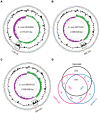Isolation and characterization of a native avirulent strain of Streptococcus suis serotype 2: a perspective for vaccine development
- PMID: 25891917
- PMCID: PMC4402706
- DOI: 10.1038/srep09835
Isolation and characterization of a native avirulent strain of Streptococcus suis serotype 2: a perspective for vaccine development
Abstract
Streptococcus suis, an emerging infectious pathogen, is the cause of two large-scale outbreaks of human streptococcal toxic shock syndrome in China, and has attracted much attention from the scientific community. The genetic basis of its pathogenesis remains enigmatic, and no effective prevention measures have been established. To better understand the virulence differentiation of S. suis and develop a promising vaccine, we isolated and sequenced a native avirulent S. suis strain (05HAS68). Animal experiments revealed that 05HAS68 is an avirulent strain and could protect piglets from the attack of virulent strains. Comparative genomics analyses demonstrated the genetic basis for the lack of virulence in 05HAS68, which is characterized by the absence of some important virulence-associated factors and the intact 89K pathogenicity island. Lack of virulence was also illustrated by reduced survival of 05HAS68 compared to a virulent strain in pig whole blood. Further investigations revealed a large-scale genomic rearrangement in 05HAS68, which was proposed to be mediated by transposase genes and/or prophages. This genomic rearrangement may have caused the genomic diversity of S. suis, and resulted in biological discrepancies between 05HAS68 and highly virulent S. suis strains.
Figures





Similar articles
-
Genome-wide analysis of an avirulent strain that induces protective immunity against challenge with virulent Streptococcus suis serotype 2.BMC Microbiol. 2017 Mar 14;17(1):67. doi: 10.1186/s12866-017-0971-0. BMC Microbiol. 2017. PMID: 28292261 Free PMC article.
-
Comparative genomic analysis shows that Streptococcus suis meningitis isolate SC070731 contains a unique 105K genomic island.Gene. 2014 Feb 10;535(2):156-64. doi: 10.1016/j.gene.2013.11.044. Epub 2013 Dec 4. Gene. 2014. PMID: 24316490
-
SssP1, a Streptococcus suis Fimbria-Like Protein Transported by the SecY2/A2 System, Contributes to Bacterial Virulence.Appl Environ Microbiol. 2018 Aug 31;84(18):e01385-18. doi: 10.1128/AEM.01385-18. Print 2018 Sep 15. Appl Environ Microbiol. 2018. PMID: 30030221 Free PMC article.
-
Uncovering newly emerging variants of Streptococcus suis, an important zoonotic agent.Trends Microbiol. 2010 Mar;18(3):124-31. doi: 10.1016/j.tim.2009.12.003. Epub 2010 Jan 12. Trends Microbiol. 2010. PMID: 20071175 Review.
-
Virulence factors involved in the pathogenesis of the infection caused by the swine pathogen and zoonotic agent Streptococcus suis.Future Microbiol. 2012 Feb;7(2):259-79. doi: 10.2217/fmb.11.149. Future Microbiol. 2012. PMID: 22324994 Review.
Cited by
-
Virulence Studies of Different Sequence Types and Geographical Origins of Streptococcus suis Serotype 2 in a Mouse Model of Infection.Pathogens. 2016 Jul 11;5(3):48. doi: 10.3390/pathogens5030048. Pathogens. 2016. PMID: 27409640 Free PMC article.
-
Evolution and Diversity of the Antimicrobial Resistance Associated Mobilome in Streptococcus suis: A Probable Mobile Genetic Elements Reservoir for Other Streptococci.Front Cell Infect Microbiol. 2016 Oct 7;6:118. doi: 10.3389/fcimb.2016.00118. eCollection 2016. Front Cell Infect Microbiol. 2016. PMID: 27774436 Free PMC article.
-
Population structure, genetic diversity and pathotypes of Streptococcus suis isolated during the last 13 years from diseased pigs in Switzerland.Vet Res. 2020 Jul 8;51(1):85. doi: 10.1186/s13567-020-00813-w. Vet Res. 2020. PMID: 32641158 Free PMC article.
-
Comparative genomics analysis of Streptococcus iniae isolated from Trachinotus ovatus: novel insight into antimicrobial resistance and virulence differentiation.BMC Genomics. 2023 Dec 14;24(1):775. doi: 10.1186/s12864-023-09882-5. BMC Genomics. 2023. PMID: 38097934 Free PMC article.
-
Micro-evolution of three Streptococcus species: selection, antigenic variation, and horizontal gene inflow.BMC Evol Biol. 2019 Mar 27;19(1):83. doi: 10.1186/s12862-019-1403-6. BMC Evol Biol. 2019. PMID: 30917781 Free PMC article.
References
-
- Gottschalk M., Xu J., Calzas C. & Segura M. Streptococcus suis: a new emerging or an old neglected zoonotic pathogen? Future Microbiol. 5, 371–391 (2010). - PubMed
-
- Wertheim H. F., Nghia H. D., Taylor W. & Schultsz C. Streptococcus suis: an emerging human pathogen. Clin Infect Dis. 48, 617–625 (2009). - PubMed
-
- Lun Z. R., Wang Q. P., Chen X. G., Li A. X. & Zhu X. Q. Streptococcus suis: an emerging zoonotic pathogen. Lancet Infect Dis. 7, 201–209 (2007). - PubMed
Publication types
MeSH terms
Substances
LinkOut - more resources
Full Text Sources
Other Literature Sources
Molecular Biology Databases

